Tropaeolum majus
Tropaeolum majus (garden nasturtium, Indian cress, or monks cress) is a species of flowering plant in the family Tropaeolaceae, originating in the Andes from Bolivia north to Colombia. An easily-grown annual with disc-shaped leaves and brilliant orange or red flowers, it is of cultivated, probably hybrid origin.[3] It is not closely related to the genus Nasturtium (which includes watercress).
| Tropaeolum majus | |
|---|---|
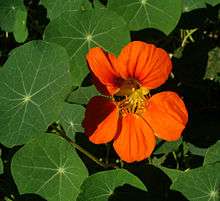 | |
| Flower and foliage | |
| Scientific classification | |
| Kingdom: | Plantae |
| Clade: | Tracheophytes |
| Clade: | Angiosperms |
| Clade: | Eudicots |
| Clade: | Rosids |
| Order: | Brassicales |
| Family: | Tropaeolaceae |
| Genus: | Tropaeolum |
| Species: | T. majus |
| Binomial name | |
| Tropaeolum majus | |
| Synonyms[1][2] | |
| |
Etymology
The Latin specific epithet majus means “larger”.[4]
Description
It is a fast-growing plant, with trailing stems growing to 3–6 ft (0.91–1.83 m). The leaves are large, nearly circular, 3 to 15 centimetres (1.2 to 5.9 in) in diameter, green to glaucous green above, paler below; they are peltate, with the 5–30 cm long petiole near the middle of the leaf, with several veins radiating to the smoothly rounded or slightly lobed margin. The flowers are 2.5–6 cm diameter, with five petals, eight stamens, and a 2.5–3 cm long nectar spur at the rear; they vary from yellow to orange to red, frilled and often darker at the base of the petals. The fruit is 2 cm broad, three-segmented, each segment with a single large seed 1–1.5 cm long.[5][6]
Das Elisabeth Linné-Phänomen
Das Elisabeth Linné-Phänomen, or the Elizabeth Linnæus Phenomenon, is the name given to the phenomenon of "flashing flowers".[7] Especially at dusk, the orange flowers may appear to emit small "flashes". Once believed to be an electrical phenomenon, it is today thought to be an optical reaction in the human eye caused by the contrast between the orange flowers and the surrounding green. The phenomenon is named after Elisabeth Christina von Linné, one of Carl Linnaeus's daughters, who discovered it at age 19.[8]
Ecology
The garden nasturtium is used as a food plant by the larvae of some Lepidoptera species including the dot moth[9] and the garden carpet moth.[10] A common pest found on nasturtiums is the caterpillar of the large white or cabbage white butterfly.[11]
Invasive species
The species has become naturalized in parts of the United States (California, New York, Pennsylvania, New Hampshire, Massachusetts, Connecticut and Virginia),[12][13] as well as parts of Europe, such as Gibraltar,[14] and Asia, Africa and Australia.[12] It is also listed as invasive in Hawaii and Lord Howe Island, Australia.[6]
Cultivation and uses
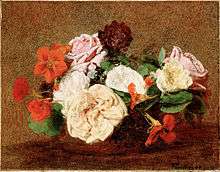
Tropaeolum majus cultivars are widely grown as easy annual plants, for poor, damp soil in full sun. The large seeds are easy to handle individually. As they do not tolerate heavy frost they are best sown under glass in heat, and planted out after all danger of frost has passed. Alternatively, as they are fast-growing, they may be sown in situ in May or June. Many flower colours are available, in the warm spectrum from cream through yellow, orange, red and maroon. Some have highly decorative marbling on the leaves. The groups Whirlybird Series[15] and Alaska Series[16] have gained the Royal Horticultural Society’s Award of Garden Merit.[17]
Culinary
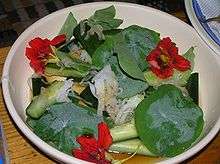
All of the above-ground parts of the plants are edible.[18] The flower has most often been consumed, making for an especially ornamental salad ingredient; it has a slightly peppery taste reminiscent of watercress, and is also used in stir fry. The flowers contain about 130 mg vitamin C per 100 grams (3.5 oz),[19] about the same amount as is contained in parsley.[20] Moreover, they contain up to 45 mg of lutein per 100 gr,[21] which is the highest amount found in any edible plant. The unripe seed pods can be harvested and dropped into spiced vinegar to produce a condiment and garnish, sometimes used in place of capers.[22]
Gallery
.jpg) Flowering yellow and red Tropaeolum majus (Garden nasturtium)
Flowering yellow and red Tropaeolum majus (Garden nasturtium) Flower showing nectar spur
Flower showing nectar spur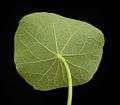 Underside of leaf showing petiole attachment
Underside of leaf showing petiole attachment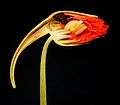 Flower cut through to show structure
Flower cut through to show structure Immature fruit
Immature fruit
References
- Tropicos
- The Plant List
- Huxley, A., ed. (1992). New RHS Dictionary of Gardening. Macmillan ISBN 0-333-47494-5.
- Harrison, Lorraine (2012). RHS Latin for Gardeners. United Kingdom: Mitchell Beazley. ISBN 978-1845337315.
- Jepson Flora: Tropaeolum majus
- Pacific Island Ecosystems at Risk: Tropaeolum majus
- H. W. "Das Elisabeth Linné-Phänomen (sogenanntes Blitzen der Blüten) und seine Deutungen", Nature (nature.com). Retrieved 4 May 2013.
- "Försenad jätteplantering till Malmös schlagerfest, expert varnar för kalkning och kogödsel på påse", Odla med P1, Sveriges Radio, 29 April 2013. Retrieved 4 May 2013. (in Swedish)
- "Dot Moth - Melanchra persicariae". Recording the wildlife of Leicestershire and Rutland. NatureSpot. Retrieved 2012-06-21.
- Plymley, Katherine. "Garden Carpet Moth and Caterpillar Xanthorhoe fluctuata, Nasturtium". Shrewsbury Museums Service. Retrieved 2012-06-21.
- "Cabbage caterpillars". Royal Horticultural Society. 2011-02-22. Retrieved 2012-06-21.
- Flora of North America v 7 p 166
- "Plants Profile for Tropaeolum majus (nasturtium)". plants.usda.gov. Retrieved 2018-03-07.
- "Dicots | Flora of Gibraltar". floraofgibraltar.myspecies.info. Retrieved 2018-03-07.
- "RHS Plantfinder - Tropaeolum majus Whirlybird Series". Retrieved 26 December 2018.
- "RHS Plantfinder - Tropaeolum majus Alaska Series". Retrieved 26 December 2018.
- "AGM Plants - Ornamental" (PDF). Royal Horticultural Society. July 2017. p. 103. Retrieved 26 December 2018.
- Nyerges, Christopher (2016). Foraging Wild Edible Plants of North America: More than 150 Delicious Recipes Using Nature's Edibles. Rowman & Littlefield. p. 124. ISBN 978-1-4930-1499-6.
- "Tropaeolum minus". Plants For A Future. Retrieved 2012-06-05.
- United States Department of Agriculture Research Service (2010). "USDA National Nutrient Database for Standard Reference, Release 23". Nutrient Data Laboratory. Cite journal requires
|journal=(help) - Niizu, P.Y. & Rodriguez-Amaya, Delia B. (2005). "Flowers and Leaves of Tropaeolum majus L. as Rich Sources of Lutein". Journal of Food Science. 70 (9): S605–S609. doi:10.1111/j.1365-2621.2005.tb08336.x. ISSN 1750-3841.
- Owen, Marion. "Poor Man's Capers: How to make gourmet capers from nasturtium seed pods". Retrieved 2012-06-24.
| Wikimedia Commons has media related to Tropaeolum majus. |